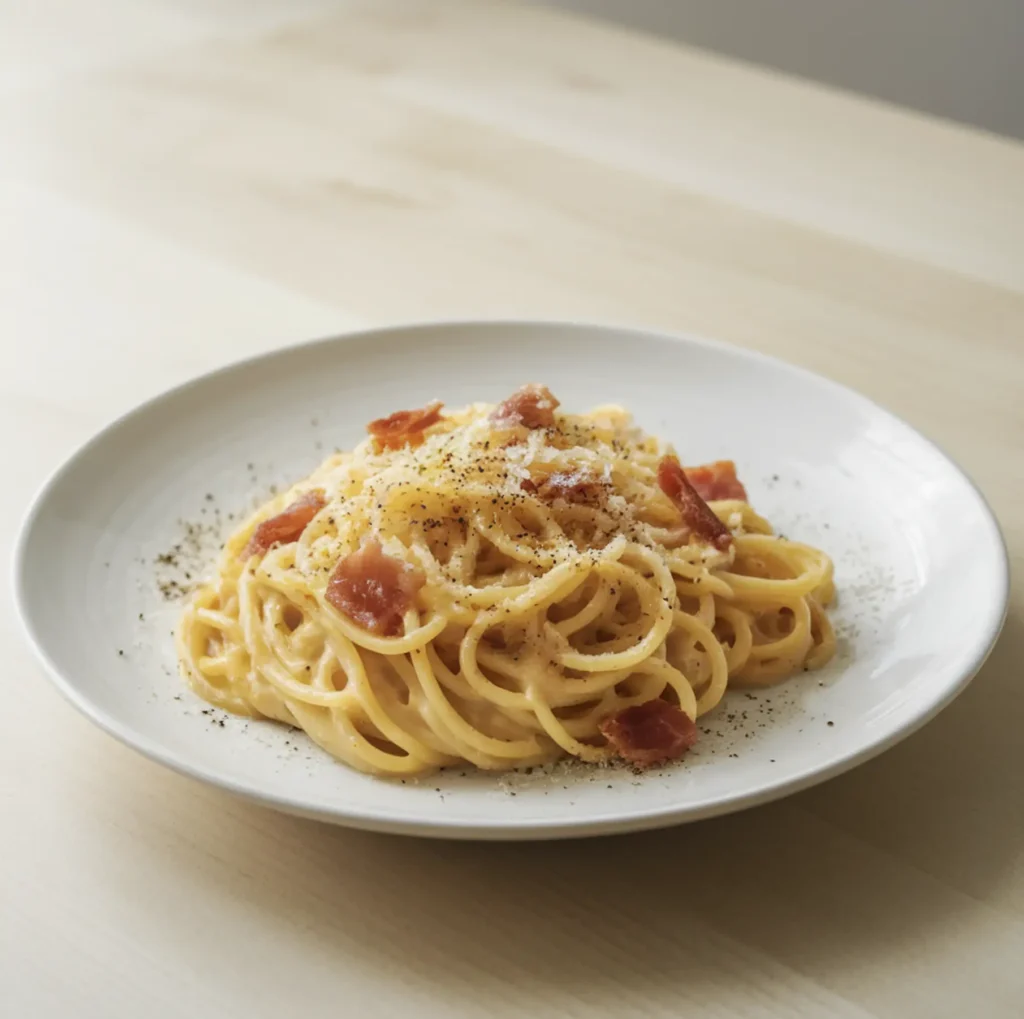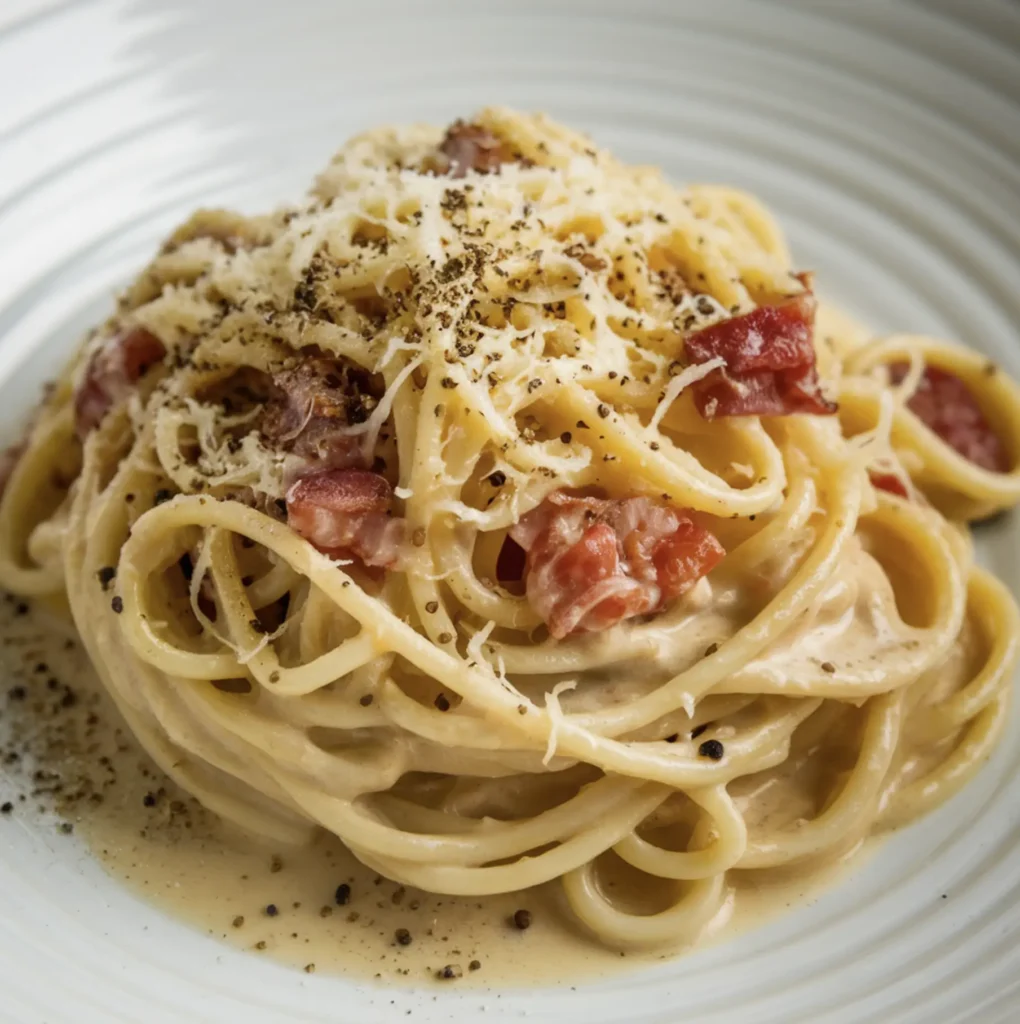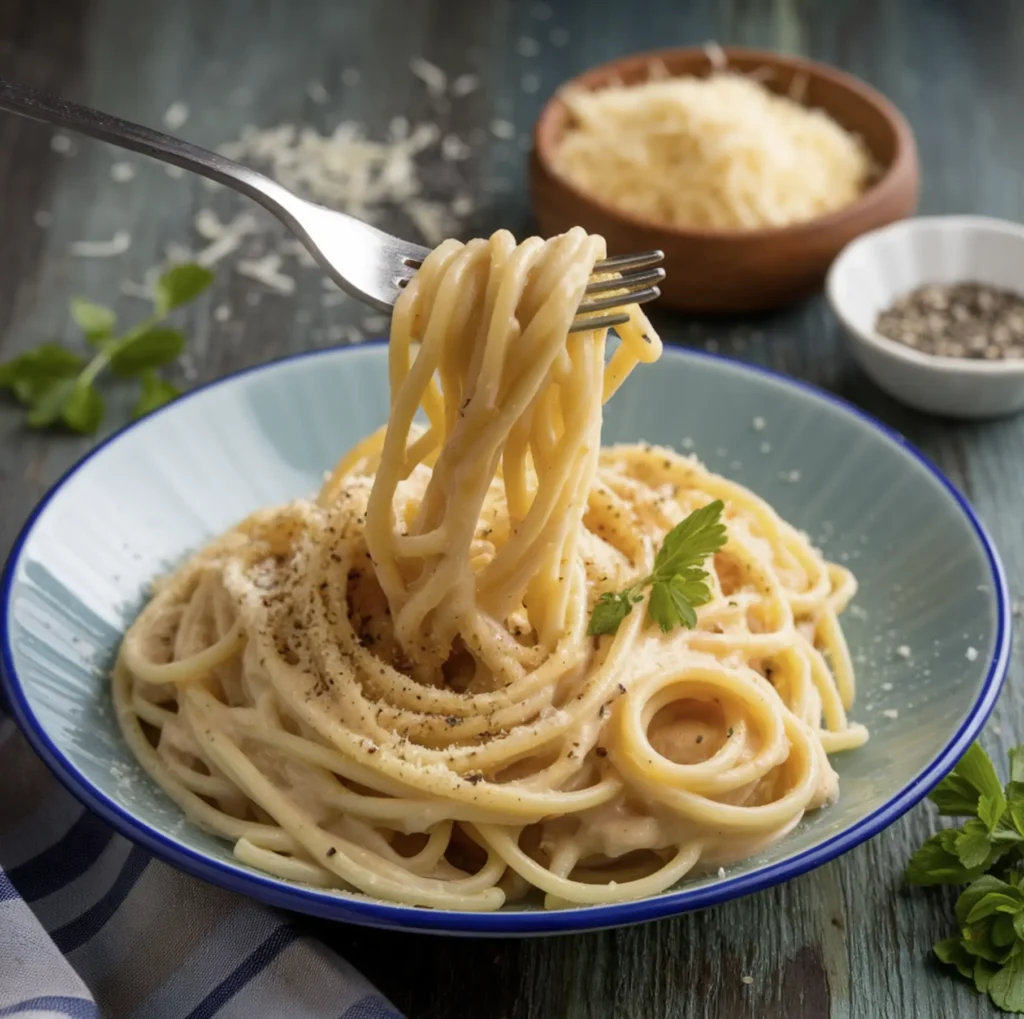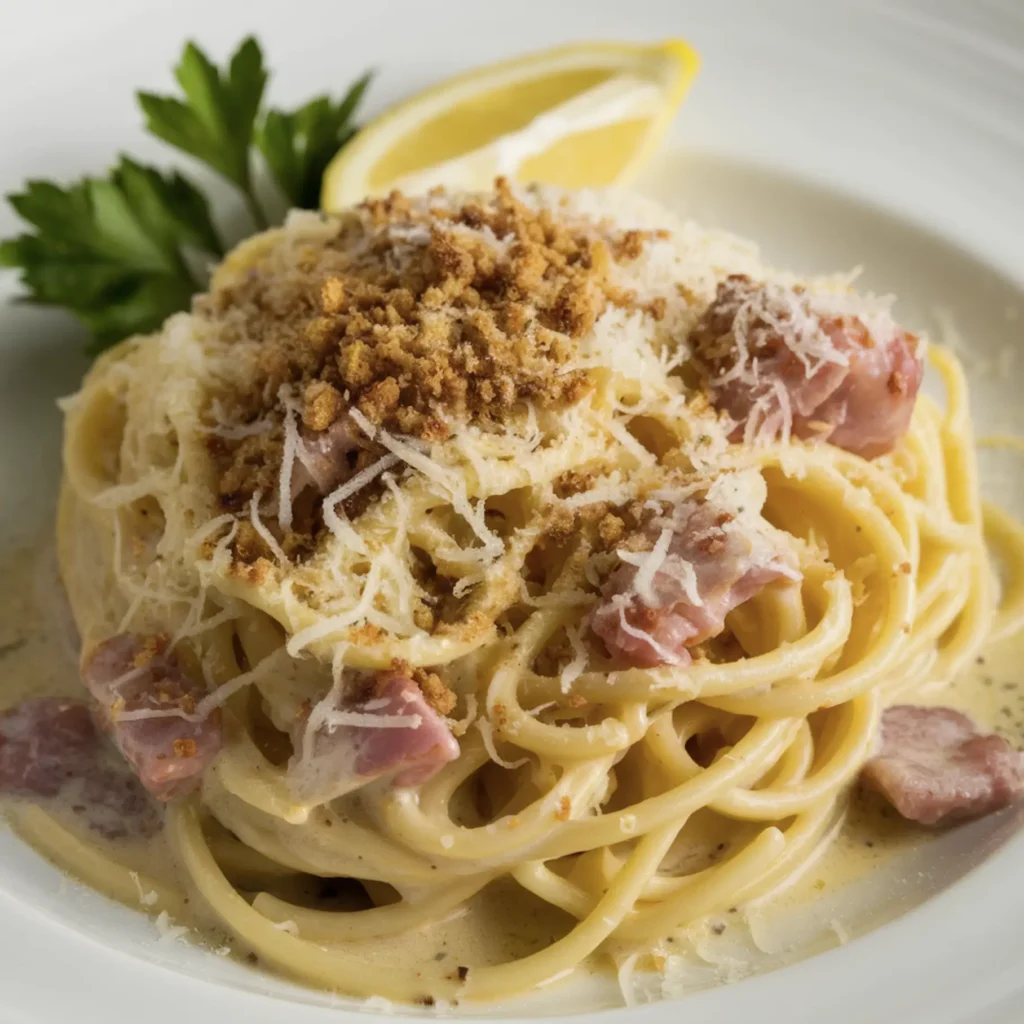When it comes to iconic pasta dishes, spaghetti carbonara stands out as a timeless favorite, Spaghetti carbonara is one of the most celebrated Italian pasta dishes, loved for its creamy, velvety sauce and the rich, savory flavors of cheese and pancetta. Whether it’s served at a family dinner or a fine dining restaurant, this dish never fails to impress. However, achieving the perfect, silky sauce without scrambling the eggs can be a challenge for even the most experienced cooks. The good news is that with a bit of patience and technique, it’s entirely possible to make spaghetti carbonara without scrambling the eggs.
The key to success lies in mastering the balance of heat and timing. In this guide, we’ll explore how to prepare spaghetti carbonara with a luscious, creamy sauce while avoiding common mistakes like curdling the eggs. Above all, this step-by-step approach ensures consistent results every time. In addition, this article will highlight creative variations, tips, and solutions to help you elevate your carbonara game.
For instance, we’ll delve into the role of ingredients like pasta water, cheese, and black pepper, which are essential for creating an authentic carbonara. By understanding these elements and perfecting your technique, even beginners can master this classic dish. As a result, you’ll impress family and friends with a restaurant-quality meal prepared in your own kitchen.
Why Do Eggs Scramble in Spaghetti Carbonara and How to Avoid It?
The creamy texture of spaghetti carbonara depends on a delicate balance of heat and timing. Unfortunately, this balance can be disrupted, causing the eggs to scramble. This happens when the eggs are exposed to excessive heat or added at the wrong moment during the cooking process.
For example, pouring the egg mixture onto piping hot pasta fresh from the boiling pot can cook the eggs too quickly, forming curds instead of a smooth sauce. In addition, mixing the eggs on direct heat—such as in a hot skillet—can cause the proteins to coagulate too rapidly. Both scenarios lead to an unpleasant, clumpy texture that detracts from the creamy consistency carbonara is known for.
Tempering the eggs is a crucial step that many skip. By gradually warming the eggs with small amounts of hot pasta water before adding them to the dish, you can reduce the risk of scrambling. As a result, the sauce thickens gently and evenly without overheating.
Moreover, it’s essential to remove the skillet from direct heat before combining the eggs with the pasta. Residual heat is sufficient to cook the sauce without curdling the eggs. In short, attention to timing and technique ensures a perfectly smooth, velvety sauce every time you prepare spaghetti carbonara without scrambling the eggs.
For more pasta inspiration, explore our What Makes Drunken Noodles Drunken for a unique twist on noodles.
The Science Behind Perfect Carbonara Sauce Without Scrambling the Eggs
The magic of spaghetti carbonara lies in its simplicity. This dish doesn’t rely on heavy creams or complex ingredients to achieve its creamy texture. Instead, it’s a harmonious blend of eggs, cheese, and pasta water that creates the luxurious coating for the pasta. However, the science behind this transformation is what truly sets carbonara apart.
For example, the egg yolks in the mixture act as an emulsifier, binding the fat from the cheese and pancetta with the starch from the pasta water. This process forms a silky, cohesive sauce that clings beautifully to the noodles. In contrast, scrambling happens when the mixture overheats, causing the proteins in the eggs to coagulate too quickly and separate.
In addition, the temperature and method of stirring play a critical role in achieving the perfect sauce. Whisking the egg mixture continuously while gradually incorporating warm pasta water tempers the eggs and prevents them from curdling. As a result, the sauce thickens evenly, maintaining its creamy consistency.
Moreover, using freshly grated cheese—such as Pecorino Romano or Parmesan—ensures smooth melting and enhances the flavor. Pre-grated cheese often contains additives that can interfere with the sauce’s texture. In conclusion, mastering these small yet significant details allows you to make spaghetti carbonara without scrambling the eggs, resulting in a restaurant-quality dish you’ll want to make again and again.
Why Carbonara Doesn’t Need Cream

Many people believe that adding cream to spaghetti carbonara is necessary to achieve a rich, creamy texture. However, this is a misconception rooted in modern adaptations rather than traditional Italian cooking. Authentic carbonara relies entirely on the combination of eggs, cheese, and pasta water to create its luxurious sauce. In fact, adding cream not only alters the flavor profile but also masks the simplicity that defines this dish.
For example, the yolks in the eggs naturally thicken the sauce when combined with the grated cheese, creating a velvety consistency. Moreover, the starchy pasta water works as a binder, ensuring the sauce adheres perfectly to every strand of spaghetti. This natural emulsification process is what makes carbonara stand out from other creamy pasta dishes.
In contrast, cream can dilute the robust flavors of the cheese and pancetta, softening the sharpness that makes carbonara so unique. Authentic recipes embrace the simplicity of a few high-quality ingredients rather than relying on unnecessary additions.
In addition, focusing on technique rather than extra ingredients is the key to success. Perfectly timing the egg mixture and controlling the heat ensures a smooth and creamy sauce without needing cream. For instance, omitting cream allows the bold flavors of the pancetta (or turkey bacon) and Pecorino Romano to shine.
As a result, mastering the traditional method gives you a more authentic and flavorful dish. By understanding the role of each ingredient, you can confidently prepare spaghetti carbonara without cream and fully appreciate the timeless elegance of this Italian classic.
Step-by-Step Guide: How to Make Spaghetti Carbonara Without Scrambling the Eggs
Perfecting spaghetti carbonara may seem intimidating, but it’s entirely achievable with attention to detail. For instance, following these simple yet precise steps ensures that your carbonara comes out creamy and delicious every time.
Ingredients You’ll Need
- 400g spaghetti
- 150g pancetta (or turkey bacon for a halal-friendly option)
- 3 large eggs (2 yolks, 1 whole egg)
- 1 cup grated Pecorino Romano or Parmesan cheese
- Salt and freshly cracked black pepper
- 1 cup reserved pasta water
In addition, using high-quality cheese and pasta makes a significant difference in the final flavor and texture of the dish.
Preparation
1. Cook the Pasta:
Begin by boiling a large pot of salted water. Cook the spaghetti until it is al dente, as this texture holds the sauce best. Reserve about one cup of the starchy pasta water before draining it. Next, avoid rinsing the pasta to retain the surface starch, which is critical for emulsifying the sauce.
2. Prepare the Pancetta:
Dice the pancetta (or turkey bacon) into small pieces and cook them in a skillet over medium heat until they are crispy and golden brown. Remove the skillet from heat to prevent it from becoming too hot for the eggs. In contrast, leaving the skillet on direct heat may scramble the eggs during the mixing stage.
3. Make the Egg Mixture:
Whisk the eggs, yolks, grated cheese, and black pepper together in a bowl until the mixture is smooth and creamy. Moreover, this step ensures there are no lumps and prepares the base for the carbonara sauce.
Combining It All
4. Temper the Eggs:
To prevent the eggs from scrambling, gradually warm the egg mixture by whisking in a small amount of hot pasta water (about 2 tablespoons). As a result, the eggs reach a temperature that allows them to mix with the pasta without coagulating.
5. Toss with Pasta:
Transfer the drained pasta to the skillet with the pancetta. Toss the pasta thoroughly to coat it in the rendered fat. Next, remove the skillet from heat completely to avoid overheating the sauce during the final step.
6. Add the Egg Mixture:
Pour the tempered egg mixture over the pasta, stirring vigorously to coat each strand evenly. For example, if the sauce seems too thick, add more reserved pasta water in small increments until you achieve the desired consistency. In addition, ensure the sauce remains smooth by stirring continuously.
7. Serve Immediately:
Finally, garnish the pasta with additional grated cheese and cracked black pepper for extra flavor. Serve hot and enjoy your perfectly creamy spaghetti carbonara.
Tips to Avoid Scrambled Eggs
Making spaghetti carbonara without scrambling the eggs is all about timing and technique. In fact, avoiding common pitfalls is easier than you might think if you follow these tips:
- Remove from heat: Always take the skillet off direct heat before adding the egg mixture. Residual heat is sufficient to cook the sauce without curdling the eggs.
- Temper the eggs: Gradually warm the eggs with a few tablespoons of hot pasta water before combining them with the pasta. As a result, the eggs reach a temperature that prevents scrambling.
- Work quickly: Stir or whisk the pasta continuously to ensure the sauce stays smooth and creamy.
- Use pasta water: Incorporating starchy pasta water not only loosens the sauce but also binds it to the noodles, creating a silky finish.
For example, many people forget the importance of timing when mixing the eggs, which is why they end up with clumps. In addition, patience and careful attention to detail are crucial for achieving the perfect texture.
In short, mastering these techniques ensures you can confidently prepare spaghetti carbonara without scrambling the eggs, delivering a dish that is both authentic and delicious.
The Role of Black Pepper in Making Spaghetti Carbonara Without Scrambling the Eggs

Black pepper may seem like a simple addition, but it plays a pivotal role in spaghetti carbonara. Far from being just a garnish, it is one of the key ingredients that enhances the overall flavor profile of this classic dish. For example, its bold, aromatic taste contrasts beautifully with the creamy richness of the eggs and cheese, creating a perfect balance of flavors.
Moreover, freshly cracked black pepper is crucial to achieving the authentic taste of spaghetti carbonara. Pre-ground pepper lacks the intensity and fragrance needed to elevate the dish. In fact, many traditional recipes call for a generous amount of freshly cracked black pepper, which not only adds depth but also enhances the dish’s visual appeal with its speckled appearance.
In addition, toasting the black pepper in the rendered fat from pancetta (or turkey bacon) can take its flavor to the next level. The heat releases the natural oils in the pepper, intensifying its aroma and adding a subtle smokiness. As a result, the pepper’s flavor becomes more pronounced, complementing the savory notes of the pancetta and cheese.
Similarly, achieving the right balance of seasoning is essential. Taste the sauce as you prepare it and adjust the amount of black pepper to suit your preferences. Some people prefer a bold, peppery kick, while others may opt for a milder touch.
In short, black pepper is not just a seasoning in spaghetti carbonara—it’s a cornerstone of the recipe. By using high-quality, freshly cracked pepper and incorporating it thoughtfully, you can ensure your carbonara achieves the depth and complexity it deserves.
Choosing the Right Cheese for Carbonara
The cheese used in spaghetti carbonara is more than just a flavoring—it’s a fundamental element of the sauce’s texture and taste. In fact, the choice of cheese can dramatically influence the overall quality of the dish. Two cheeses commonly used in carbonara are Pecorino Romano and Parmesan, each offering unique characteristics.
Pecorino Romano is the traditional choice for authentic carbonara. Made from sheep’s milk, it has a robust, salty flavor that pairs beautifully with the creamy egg-based sauce. In contrast, Parmesan, which is made from cow’s milk, has a milder, nuttier profile. For those who prefer a less intense flavor, Parmesan serves as an excellent alternative.
For example, combining Pecorino Romano and Parmesan can strike a perfect balance, blending the sharpness of one with the creaminess of the other. Moreover, freshly grating the cheese is essential for achieving a smooth, melt-in-your-mouth sauce. Pre-grated cheese often contains anti-caking agents, which can interfere with melting and result in a grainy texture.
In addition, proper storage is key to maintaining the cheese’s freshness and flavor. Wrap it tightly in parchment or wax paper and store it in the refrigerator. Use the cheese within a few weeks for optimal results.
As a result, choosing the right cheese and handling it properly ensures your spaghetti carbonara has the rich, creamy flavor that makes it truly special. Whether you prefer the boldness of Pecorino Romano or the subtlety of Parmesan, this ingredient is vital to achieving a perfect dish.
Creative Variations of Spaghetti Carbonara
Spaghetti carbonara is a classic dish, but its simple ingredients and flexible nature make it easy to adapt into creative variations. For example, by making small substitutions or additions, you can customize carbonara to suit your preferences or dietary needs. These variations are especially helpful when exploring how to make spaghetti carbonara without scrambling the eggs while tailoring the recipe to your liking.
Vegetarian Carbonara
Swap pancetta for sautéed mushrooms, roasted bell peppers, or caramelized onions. In addition, herbs like thyme, parsley, or basil can enhance the flavor, adding freshness and complexity to the dish. These vegetarian options retain the dish’s richness while offering a lighter, plant-based alternative.
Seafood Carbonara
Introduce shrimp, salmon, or even scallops for a luxurious twist on traditional carbonara. For instance, seafood pairs beautifully with the creamy sauce, and a hint of lemon zest adds a bright, tangy note that complements the richness.
Low-Calorie Carbonara
Replace some of the cheese with nutritional yeast for a dairy-free alternative that still provides a cheesy flavor. Moreover, using whole-grain spaghetti and turkey bacon reduces calories while maintaining the dish’s texture and taste.
Spicy Carbonara
Add red chili flakes, cayenne pepper, or smoked paprika to introduce heat and depth. Similarly, a drizzle of chili oil or a pinch of black garlic powder can take the spice level up a notch, giving your carbonara a bold and exciting flavor profile.
In conclusion, these variations showcase the versatility of spaghetti carbonara. Whether you’re adapting the recipe for dietary preferences or experimenting with new flavors, the possibilities are endless, ensuring there’s a carbonara for every palate.
The Importance of Pasta Water in Making Spaghetti Carbonara Without Scrambling the Eggs
One of the most overlooked yet vital ingredients in spaghetti carbonara is pasta water. In fact, this starchy liquid is the secret to achieving the dish’s signature creamy texture. When pasta boils, it releases starch into the water, transforming it into a natural thickening agent. As a result, pasta water helps emulsify the cheese and eggs, binding them together to create a smooth, velvety sauce that clings perfectly to the pasta. Mastering this technique is essential when learning how to make spaghetti carbonara without scrambling the eggs.
For example, if the carbonara sauce feels too thick, a splash of pasta water can loosen it while maintaining its flavor. Similarly, if the sauce appears too dry, pasta water restores the creaminess, ensuring the pasta stays moist and flavorful. The slightly salty and warm nature of pasta water complements the dish, enhancing its overall taste.
In addition, it’s important to reserve more pasta water than you think you’ll need. You can set it aside in a cup or bowl before draining the pasta. This ensures you’ll have enough on hand to adjust the consistency of the sauce at every stage. Moreover, pasta water is critical when tempering eggs to prevent scrambling and achieve that silky finish.
In conclusion, never underestimate the role of pasta water in carbonara. By incorporating it thoughtfully, you’ll create a perfectly emulsified sauce that makes your spaghetti carbonara unforgettable.
Common Mistakes and How to Avoid Them
Even with the simplest ingredients, spaghetti carbonara can be tricky to master. In addition, being aware of common mistakes will help ensure your dish turns out flawlessly.
Adding Eggs Too Soon
Mixing eggs with pasta that’s too hot can scramble them, resulting in a clumpy sauce. Always let the pasta cool slightly before adding the egg mixture. As a result, the sauce remains creamy and smooth.
Using Too Little Pasta Water
The starchy water from cooking the pasta is critical for emulsification. For instance, it binds the eggs and cheese to form the luscious sauce carbonara is known for. Always reserve more than you think you’ll need to avoid running out during the process.
Overcooking the Pasta
Cooking the pasta past the al dente stage makes it mushy and less effective at holding the sauce. In contrast, al dente pasta retains its structure and ensures the sauce clings beautifully to each strand.
In short, understanding these common pitfalls will set you up for success. By taking these steps, you’ll create a spaghetti carbonara that’s as close to perfection as possible.
FAQs
What Is Spaghetti Carbonara?
Guanciale is a type of Italian cured meat that has a richer, more intense flavor, making it the preferred choice for traditional Carbonara. Its unique texture and savory taste contribute to a deeper, more complex flavor profile. On the other hand, pancetta has a milder flavor and a firmer texture, which makes it a more subtle choice for the dish.
What’s the Difference Between Pancetta and Guanciale in Carbonara?
Guanciale is a type of Italian cured meat that has a richer, more intense flavor, making it the preferred choice for traditional Carbonara. Its unique texture and savory taste contribute to a deeper, more complex flavor profile. On the other hand, pancetta has a milder flavor and a firmer texture, which makes it a more subtle choice for the dish.
Can I Make Carbonara Without Parmesan Cheese?
Yes, you can use Pecorino Romano instead of Parmesan, as it is the traditional cheese used in Carbonara. Pecorino has a sharper, saltier taste compared to Parmesan, which adds a distinctive flavor to the dish. However, if you prefer a milder flavor, you can opt for Parmesan instead. In fact, some people mix both cheeses for a balanced, flavorful sauce.
How to Store and Reheat Spaghetti Carbonara?
Carbonara is best served fresh, but if you need to store leftovers, place them in an airtight container and refrigerate for up to 2 days. When reheating, add a splash of reserved pasta water and gently reheat on the stove, stirring constantly to restore the creamy texture. Additionally, you can reheat it in the microwave, but be sure to add a little bit of water to prevent the sauce from becoming too thick.
Is Spaghetti Carbonara Safe for Pregnant Women?
Pregnant women should avoid raw or undercooked eggs due to the risk of salmonella. To make Carbonara safe, use pasteurized eggs or carefully cook the egg mixture to ensure it’s fully cooked. As a result, you can enjoy Carbonara without any safety concerns, as pasteurized eggs carry a lower risk of foodborne illnesses.
Get the Classic Spaghetti Carbonara Recipe Now!
Ready to make the ultimate Italian dish? Dive into our step-by-step guide to making Classic Spaghetti Carbonara that’s as authentic as it gets! 🍝
From selecting the right ingredients to perfecting the sauce, we’ve got everything you need to create this timeless favorite. Start cooking the perfect Carbonara today, and bring a taste of Italy to your kitchen!
Conclusion

In conclusion, making spaghetti carbonara without scrambling the eggs requires precision, patience, and attention to detail. By following the proper steps, such as tempering the eggs, controlling the heat, and using reserved pasta water, you can achieve a creamy, luscious sauce that stays true to its authentic roots. This traditional dish doesn’t need cream or excessive ingredients—its simplicity is what makes it so special.
Spaghetti carbonara is not just a meal; it’s an experience. Whether you’re preparing it for a weeknight dinner or a special occasion, its depth of flavor and creamy texture are sure to impress. If you’re looking for more ideas to elevate your pasta game, consider trying this Seafood Pasta Recipe, which offers another take on Italian-inspired flavors.
For more tips and insights into mastering carbonara, you can also check out this helpful guide from An Italian in My Kitchen. It provides a closer look at the traditional techniques behind this iconic dish.
Above all, keep practicing and experimenting with the recipe. Spaghetti carbonara is a dish worth perfecting, and with time, it’s sure to become a beloved staple in your kitchen.



